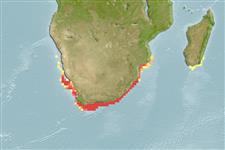>
Centrarchiformes (Basses) >
Latridae (Trumpeters)
Etymology: Chirodactylus: Greek, cheir = hand + Greek, daktylos = finger (Ref. 45335); for the long, unbranched lower pectoral fin rays (Ref. 120445).
More on author: Cuvier.
Environment: milieu / climate zone / depth range / distribution range
นิเวศวิทยา
เกี่ยวกับทะเล,น้ำเค็ม เกี่ยวกับหินโสโครก; ระดับความลึก 0 - 240 m (Ref. 9492). Subtropical; 23°S - 36°S
Southeast Atlantic and Western Indian Ocean: Walvis Bay, Namibia around the Cape to Delagoa Bay, Mozambique.
ขนาด / น้ำหนัก / Age
Maturity: Lm ? range ? - ? cm
Max length : 40.0 cm TL เพศผู้/กระเทย; (Ref. 9492); common length : 25.0 cm TL เพศผู้/กระเทย; (Ref. 9492)
Short description
เครื่องมือที่ใช้ในการแยกชนิดสัตว์,สิ่งมีชีวิตออกจากกัน | สัณฐานวิทยา | ความยาวต่างๆ
เงี่ยงครีบหลัง (รวม) : 17 - 18; ก้านครีบอ่อนที่หาง (รวม) : 28 - 31; เงี่ยงครีบก้น: 3; ก้านครีบอ่อนที่ก้น: 8 - 10.
Found in coastal waters from the shoreline to about 240 m depth, associated with reef areas (Ref. 9492) and rocky bottoms (Ref. 5319). Feeds on invertebrates (Ref. 27121).
Life cycle and mating behavior
วัยเจริญพันธุ์ | การสืบพันธุ์ | การวางไข่ | เซลสืบพันธ์ของเพศเมีย(ไข่) | ความดกของไข่ | ตัวอ่อน
Smith, M.M., 1986. Cheilodactylidae. p. 667-668. In M.M. Smith and P.C. Heemstra (eds.) Smiths' sea fishes. Springer-Verlag, Berlin. (Ref. 5319)
IUCN Red List Status (Ref. 130435: Version 2024-2)
Threat to humans
Harmless
Human uses
การประมง: มีการค้าเพียงเล็กน้อย; การตกปลาเป็นกีฬา: ใช่
เครื่องมือ
Special reports
Download XML
แหล่งที่มาจากอินเตอร์เน็ต
Estimates based on models
Preferred temperature (Ref.
123201): 12.2 - 24.5, mean 16.4 °C (based on 44 cells).
Phylogenetic diversity index (Ref.
82804): PD
50 = 0.6250 [Uniqueness, from 0.5 = low to 2.0 = high].
Bayesian length-weight: a=0.01175 (0.00550 - 0.02508), b=3.04 (2.85 - 3.23), in cm total length, based on LWR estimates for this (Sub)family-body shape (Ref.
93245).
ระดับชั้นอาหาร (Ref.
69278): 3.5 ±0.37 se; based on food items.
ความสามารถในการกลับคืนสู่ปกติ (Ref.
120179): ขนาดกลาง, เวลาต่ำสุดที่จะทำให้ประชากรเพิ่มขึ้นเป็น 2 เท่าใช้เวลา 1.4 - 4.4 ปี (Preliminary K or Fecundity.).
Fishing Vulnerability (Ref.
59153): Low to moderate vulnerability (30 of 100).
Nutrients (Ref.
124155): Calcium = 25.7 [12.7, 51.9] mg/100g; Iron = 0.525 [0.321, 0.852] mg/100g; Protein = 19.7 [17.9, 21.6] %; Omega3 = 0.244 [0.154, 0.378] g/100g; Selenium = 20 [10, 35] μg/100g; VitaminA = 52.7 [19.1, 148.3] μg/100g; Zinc = 0.777 [0.537, 1.125] mg/100g (wet weight);
